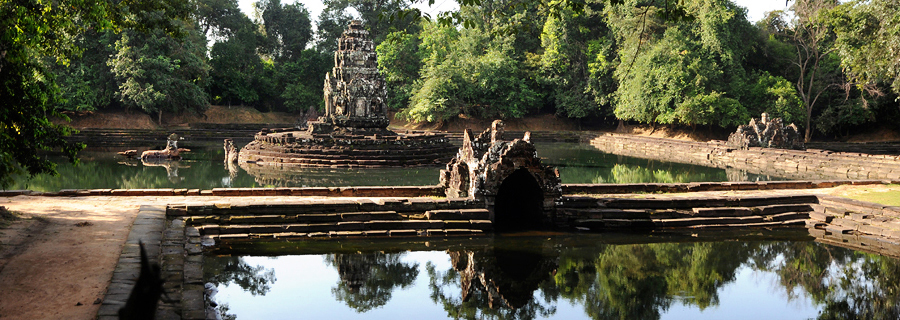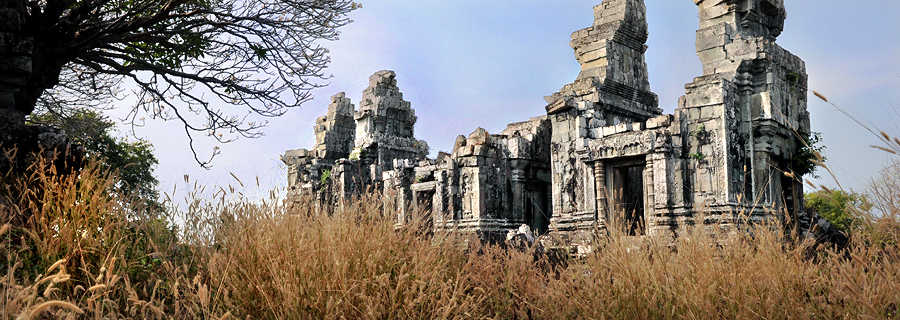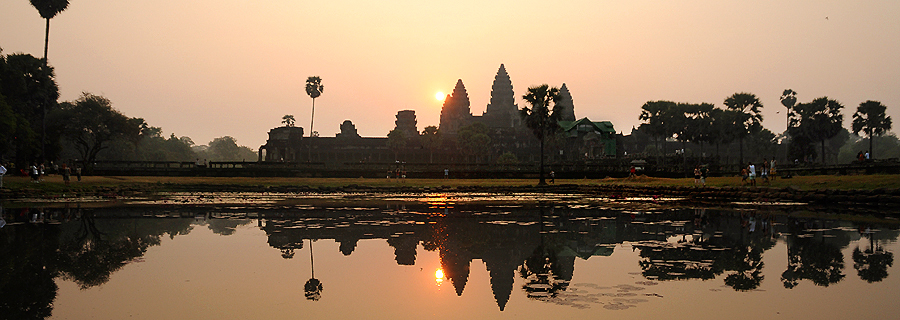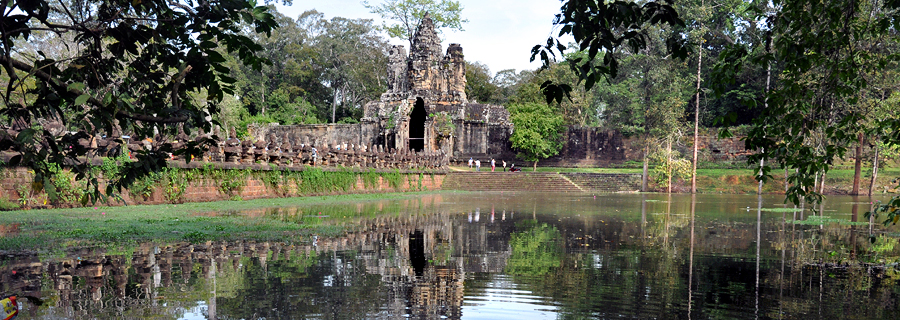Angkor temples - summary
People for the first time taking note of the fascinating ancient Khmer civilization often think, Angkor and Angkor Wat would be the same. This equalization, though inapplicable, is venial und understandable, as Angkor Wat evidently is the unsurpassed zenith of Asian temple architecture, landmark of Cambodia, and therefore, on its own, worth long journeys to Cambodia, and to Siem Reap in particular, which is the gateway to this unique monument.
But remember, just as widespread as the identification of Angkor with the five towers of the Angkor Wat, are other associations, viz. that ancient Khmer temples have monumental smiling Buddha faces carved at towers, or that they are surmounted by giant trees and strangled by their roots. Both kinds of emblematic Angkor images are not at all found at the Angkor Wat! In fact, face-towers characterize Angkor Thom. And the most famous and ever-photographed jungletemple is called Ta Prohm, situated at another location in the archaelogical zone.
Besides those three very different major tourist destinations in Angkor, there is much more to see in this ancient Khmer empire capital now situated in a jungle. Two dozens of breathtaking monuments can be visited during a three-days period of time. Apart from Banteay Srei, none of them is more than 15 kilometres away from the hotels in Siem Reap.
In order to receive a first impression or rough idea of the abundance in attractions in Angkor, please read this introduction. For more details study the pages found under the headline "Angkor" in our main menue bar, or click the links in the text below. In case you like to read an overview about the locality with maps, please click here.
__________
Angkor, a loanword simply meaning "city", was the capital of the Khmer empire between the begin of the 10th and the middle of the 15th century. But the relevant period of monumental Khmer architecture starts already in the 9th century in Roluos, 15 km to the east of Siem Reap and southeast of Angkor. The the last Khmer monuments of imposing size are from the begin of the 13th century. In its heydays, e.g. in the first half of the 11th century and during the 12th century, Angkor most probably was the biggest city in the world, covering an area larger than present-day New York and with 700,000 or maybe even a million inhabitants. In those times the largest city in Western Europe, Paris, may just have reached the 100,000 mark.
__________
.jpg)
Successive kings erected new main temples trying to beat the achievements of their predecessors. This is why there are nine temple mountains that can be called "state temples" in Angkor and Roluos, Angkor Wat and the Bayon in Angkor Thom being actually the last and most impressive imperial temples, but not at all the only ones. To learn more about those major Khmer heritage monuments, have a look at our page called "Angkor pyramids".
__________

Apart from those elevated structures there are ground-level "flat temples" of enourmous size. Some of them are from the Angkor Wat period in the first half of the 12th century. The most beautiful flat temple in the style of Angkor Wat is Banteay Samré, the largest one is Beng Mealea outside Angkor. Some medium-sized classic temples in Angkor are also mentioned on our page "Classic Flat Temples".
__________

Besides those classic flat temples from the Suryavarman II's era there are even more and vaster at-grade temple complexes from Jayavarman VII's Bayon period. Two of them are Ta Prohm and Preah Khan, each as large as the largest contemporary cities in Western Europe. To learn more about these romantical labyrinths of ruins reconquered by the jungle, study our page in this regard, click "Angkor Jungletemples".
__________

Apart from those most gigantic monuments, there are lovely smaller temples with fewer so-called "Prasats", those high-roofed "temple-towers" being the hallmark of ancient Khmer sanctuaries. Many structures with more than one Prasat are called "longitudinal temples", as the Prasats are usually aligned along a north-south-axis, on a single platform. Some of them are not founded by kings, but by other dignitaries, and therefore called "private temples". You can find a list of many of them on our "Angkor Templetowers" page.
__________

The largest structures built by the ancient Khmer were not their famous temples belonging to the hugest religious complexes of the entire world, but the dams of reservoirs called Barays. Barays may have been functional buildings, but they were of religious signicance, too. Almost every Baray served as a gigantic moat for a small temple on an artificial island close to the centre of the reservoir. These island temples are called Mebons. Neak Pean, the last one, is of exceptional beauty and remains to be a mystery. Read more on our page "Angkor Island Temples".
__________

Last, not least, we reveal those "hidden treasures" that are not visited by busgroups and a little bit more difficult to find or reach. Nevertheless, some guests love tranquil sites because of their authentic flair of "discovering the lost city in the jungle" . You can find our insider tips on the page called "Angkor Secret Places".
__________
The minimum you should know about the ways to visit Angkor is this:
For access to all major temples in Angkor and Roluos plus Banteay Srei plus Kbal Spean you need one single ticket. The counter is halfway between Siem Reap town and Angkor Wat. In case you do not book one of our packages including the entrance fees, you can buy a 1-day Angkor ticket for 20 US-Dollars, a 3-days ticket (valid for three days of your choice within one week) for 40 US-Dollars, and a 7-days-ticket (for seven days of your choice within one month) for 60 US-Dollar.
__________

Angkor Wat is the southernmost of the temples in the Archaeological Park of Angkor, which is situated to the north of Siem Reap. Usually your daytour in Angkor will begin and end at the moat of Angkor Wat. From Angkor Wat's main entrance at its western side the road through Angkor leads northwards. Before reaching Angkor Thom you will see a natural hill on the left side. It is Phnom Bakheng with Angkor's first state temple on its top. At the basis of this hill is a less big but very typical and lovely pyramid called Baksei Chamkrong. It is very close to the South Gate of Angkor Thom.
__________

Angkor Thom, the last city founded in the Angkor area, is surrounded by a moat of 3 km length and 3 km width. In each cardinal point there is an ancient gateway. Angkor Thom is the major place, though not the only one, where you can see the colossal Buddha faces smiling from the upper parts of steep buildings. There is more than one building with face-towers in Angkor Thom, the most famous ones are the South Gate, well-known for its restored row of giant sculptures forming the railings of the causeway, and the Bayon temple in the very centre of Angkor Thom. The Bayon temple has more than a hundred of those enigmatic Buddha faces. All the face-tower structures are from the era of Angkor Thom's founder Jayavarman VII. (1181- ca.1218).
But there are older structures of former cities inside the area that became Angkor Thom. The Baphuon not far away from the Bayon is the most remarkable of them. The Baphuon temple is already from the mid-eleventh century. It is located near the "Royal Square" of Angkor Thom. This square is framed by the Elephant and Leper King Terraces in front of the former Royal palace to the west and by twelve towers called Suor Prat in front of to long rectangular Khleang buildings to the east.
__________
Right in the middle of Angkor Thom's Royal Square, sometimes also called Victory Square, is a fork. The road of the so-called Small Circuit leads from here to the east, the Grand Circuit road further to the north.
__________
Along the Small Circuit you will pass Angkor Thom's Victory Gate and then see the medium-sized temples Thommanon and Chau Say Tevoda from the Angkor Wat art period. The highest monument at the Small Circuit is Ta Keo, a construction from the 10th century. The most intriguing attraction at the Small Circuit is Angkor's "Jungletemple" Ta Prohm. It has a slightly smaller neighbour called Banteay Kdei. Both are from the same period, built by same Jayavarman VII who later on founded Angkor Thom. In front of the flat temple Banteay Kdei there is a much older historical reservoir called Srah Srang. Here the Small Circuit road meets the Grand Circuit again. On the way back southwestwards to Angkor Wat, you can visit the longitudinal temple Prasat Kravan.
__________
The Grand Circuit Road crosses Angkor Thom's North Gate and then reaches the western entrance of Preah Khan, a flat temple even larger than Ta Prohm. The next stop usually is the exceptional island temple Neak Pean. The farest point is Ta Som in the north-eastern corner of the Grand Circuit, it is famous for a tree strangling its eastern gate. All these structures are from Jayavarman VII, a period called Bayon-style. The last two major monuments along the Grand Circuit are 250 years older. The East Mebon and Pre Rup, similar in style, are from the mid-tenth century, founded by King Rajendravarman II, who also built the Srah Srang reservoir, where Small and Grand Tour meet again.
You should spend a full day for the Small Circuit (also called "Small Tour") and another full day for the Grand Circuit (Grand Tour). One more day (with a 3-days-ticket) could combine Roluos to the southeast, Banteay Samre to the east and Banteay Srei to the northeast of Angkor. In case you want to visit Phnom Kulen, Beng Melea or the "Great Lake", too, you need additional half-day-excursions for each of these three destinations.
But remember, just as widespread as the identification of Angkor with the five towers of the Angkor Wat, are other associations, viz. that ancient Khmer temples have monumental smiling Buddha faces carved at towers, or that they are surmounted by giant trees and strangled by their roots. Both kinds of emblematic Angkor images are not at all found at the Angkor Wat! In fact, face-towers characterize Angkor Thom. And the most famous and ever-photographed jungletemple is called Ta Prohm, situated at another location in the archaelogical zone.
Besides those three very different major tourist destinations in Angkor, there is much more to see in this ancient Khmer empire capital now situated in a jungle. Two dozens of breathtaking monuments can be visited during a three-days period of time. Apart from Banteay Srei, none of them is more than 15 kilometres away from the hotels in Siem Reap.
In order to receive a first impression or rough idea of the abundance in attractions in Angkor, please read this introduction. For more details study the pages found under the headline "Angkor" in our main menue bar, or click the links in the text below. In case you like to read an overview about the locality with maps, please click here.
__________
Angkor, a loanword simply meaning "city", was the capital of the Khmer empire between the begin of the 10th and the middle of the 15th century. But the relevant period of monumental Khmer architecture starts already in the 9th century in Roluos, 15 km to the east of Siem Reap and southeast of Angkor. The the last Khmer monuments of imposing size are from the begin of the 13th century. In its heydays, e.g. in the first half of the 11th century and during the 12th century, Angkor most probably was the biggest city in the world, covering an area larger than present-day New York and with 700,000 or maybe even a million inhabitants. In those times the largest city in Western Europe, Paris, may just have reached the 100,000 mark.
__________
.jpg)
Successive kings erected new main temples trying to beat the achievements of their predecessors. This is why there are nine temple mountains that can be called "state temples" in Angkor and Roluos, Angkor Wat and the Bayon in Angkor Thom being actually the last and most impressive imperial temples, but not at all the only ones. To learn more about those major Khmer heritage monuments, have a look at our page called "Angkor pyramids".
__________

Apart from those elevated structures there are ground-level "flat temples" of enourmous size. Some of them are from the Angkor Wat period in the first half of the 12th century. The most beautiful flat temple in the style of Angkor Wat is Banteay Samré, the largest one is Beng Mealea outside Angkor. Some medium-sized classic temples in Angkor are also mentioned on our page "Classic Flat Temples".
__________

Besides those classic flat temples from the Suryavarman II's era there are even more and vaster at-grade temple complexes from Jayavarman VII's Bayon period. Two of them are Ta Prohm and Preah Khan, each as large as the largest contemporary cities in Western Europe. To learn more about these romantical labyrinths of ruins reconquered by the jungle, study our page in this regard, click "Angkor Jungletemples".
__________

Apart from those most gigantic monuments, there are lovely smaller temples with fewer so-called "Prasats", those high-roofed "temple-towers" being the hallmark of ancient Khmer sanctuaries. Many structures with more than one Prasat are called "longitudinal temples", as the Prasats are usually aligned along a north-south-axis, on a single platform. Some of them are not founded by kings, but by other dignitaries, and therefore called "private temples". You can find a list of many of them on our "Angkor Templetowers" page.
__________

The largest structures built by the ancient Khmer were not their famous temples belonging to the hugest religious complexes of the entire world, but the dams of reservoirs called Barays. Barays may have been functional buildings, but they were of religious signicance, too. Almost every Baray served as a gigantic moat for a small temple on an artificial island close to the centre of the reservoir. These island temples are called Mebons. Neak Pean, the last one, is of exceptional beauty and remains to be a mystery. Read more on our page "Angkor Island Temples".
__________

Last, not least, we reveal those "hidden treasures" that are not visited by busgroups and a little bit more difficult to find or reach. Nevertheless, some guests love tranquil sites because of their authentic flair of "discovering the lost city in the jungle" . You can find our insider tips on the page called "Angkor Secret Places".
__________
The minimum you should know about the ways to visit Angkor is this:
For access to all major temples in Angkor and Roluos plus Banteay Srei plus Kbal Spean you need one single ticket. The counter is halfway between Siem Reap town and Angkor Wat. In case you do not book one of our packages including the entrance fees, you can buy a 1-day Angkor ticket for 20 US-Dollars, a 3-days ticket (valid for three days of your choice within one week) for 40 US-Dollars, and a 7-days-ticket (for seven days of your choice within one month) for 60 US-Dollar.
__________

Angkor Wat is the southernmost of the temples in the Archaeological Park of Angkor, which is situated to the north of Siem Reap. Usually your daytour in Angkor will begin and end at the moat of Angkor Wat. From Angkor Wat's main entrance at its western side the road through Angkor leads northwards. Before reaching Angkor Thom you will see a natural hill on the left side. It is Phnom Bakheng with Angkor's first state temple on its top. At the basis of this hill is a less big but very typical and lovely pyramid called Baksei Chamkrong. It is very close to the South Gate of Angkor Thom.
__________

Angkor Thom, the last city founded in the Angkor area, is surrounded by a moat of 3 km length and 3 km width. In each cardinal point there is an ancient gateway. Angkor Thom is the major place, though not the only one, where you can see the colossal Buddha faces smiling from the upper parts of steep buildings. There is more than one building with face-towers in Angkor Thom, the most famous ones are the South Gate, well-known for its restored row of giant sculptures forming the railings of the causeway, and the Bayon temple in the very centre of Angkor Thom. The Bayon temple has more than a hundred of those enigmatic Buddha faces. All the face-tower structures are from the era of Angkor Thom's founder Jayavarman VII. (1181- ca.1218).
But there are older structures of former cities inside the area that became Angkor Thom. The Baphuon not far away from the Bayon is the most remarkable of them. The Baphuon temple is already from the mid-eleventh century. It is located near the "Royal Square" of Angkor Thom. This square is framed by the Elephant and Leper King Terraces in front of the former Royal palace to the west and by twelve towers called Suor Prat in front of to long rectangular Khleang buildings to the east.
__________
Right in the middle of Angkor Thom's Royal Square, sometimes also called Victory Square, is a fork. The road of the so-called Small Circuit leads from here to the east, the Grand Circuit road further to the north.
__________
Along the Small Circuit you will pass Angkor Thom's Victory Gate and then see the medium-sized temples Thommanon and Chau Say Tevoda from the Angkor Wat art period. The highest monument at the Small Circuit is Ta Keo, a construction from the 10th century. The most intriguing attraction at the Small Circuit is Angkor's "Jungletemple" Ta Prohm. It has a slightly smaller neighbour called Banteay Kdei. Both are from the same period, built by same Jayavarman VII who later on founded Angkor Thom. In front of the flat temple Banteay Kdei there is a much older historical reservoir called Srah Srang. Here the Small Circuit road meets the Grand Circuit again. On the way back southwestwards to Angkor Wat, you can visit the longitudinal temple Prasat Kravan.
__________
The Grand Circuit Road crosses Angkor Thom's North Gate and then reaches the western entrance of Preah Khan, a flat temple even larger than Ta Prohm. The next stop usually is the exceptional island temple Neak Pean. The farest point is Ta Som in the north-eastern corner of the Grand Circuit, it is famous for a tree strangling its eastern gate. All these structures are from Jayavarman VII, a period called Bayon-style. The last two major monuments along the Grand Circuit are 250 years older. The East Mebon and Pre Rup, similar in style, are from the mid-tenth century, founded by King Rajendravarman II, who also built the Srah Srang reservoir, where Small and Grand Tour meet again.
You should spend a full day for the Small Circuit (also called "Small Tour") and another full day for the Grand Circuit (Grand Tour). One more day (with a 3-days-ticket) could combine Roluos to the southeast, Banteay Samre to the east and Banteay Srei to the northeast of Angkor. In case you want to visit Phnom Kulen, Beng Melea or the "Great Lake", too, you need additional half-day-excursions for each of these three destinations.
Recommendations:

Unknown temples are small and remote, but romantic and charming. Discover the secrets
... more
... more

Apart from circuit tours we offer an alternative, visit Angkor's temples in chronological order
... more
... more

Prasat Bakan: The largest Khmer temple compound is not Angkor Wat, but Prasat Bakan, remote and ...
more

Boat Trips: Angkor may be unsurpassed, but there are more world class tourist destinations close to ...
more

Cambodia is a perfect destination for a combination of studytrip, shopping, and beach relaxation
... more
... more
Quick inquiry
Our Services:
- Airtickets domestic and worldwide
- Bus and Boat Tickets
- Visa arrangements
- Hotel or Guesthouse reservation
- Transportation rentals
- Private or shared tours in Angkor
- Guided tours in many languages
- Holiday packages
- Tailor-made roundtours
- Bus and Boat Tickets
- Visa arrangements
- Hotel or Guesthouse reservation
- Transportation rentals
- Private or shared tours in Angkor
- Guided tours in many languages
- Holiday packages
- Tailor-made roundtours
Our Specials:
- Forgotten temples off the beaten track
- Temple visits in chronological historical order
- Temple visits in chronological historical order
Unique Asia Travel and Tours
is an independent travel agency and tour operator registered in Cambodia, based in Siem Reap near Angkor.
We are not part of an international holding, we help to develop local tourist business.
Our company is run by locals and 100% owned by Cambodians.
For details, please check our page
Our company
We are not part of an international holding, we help to develop local tourist business.
Our company is run by locals and 100% owned by Cambodians.
For details, please check our page
Our company














